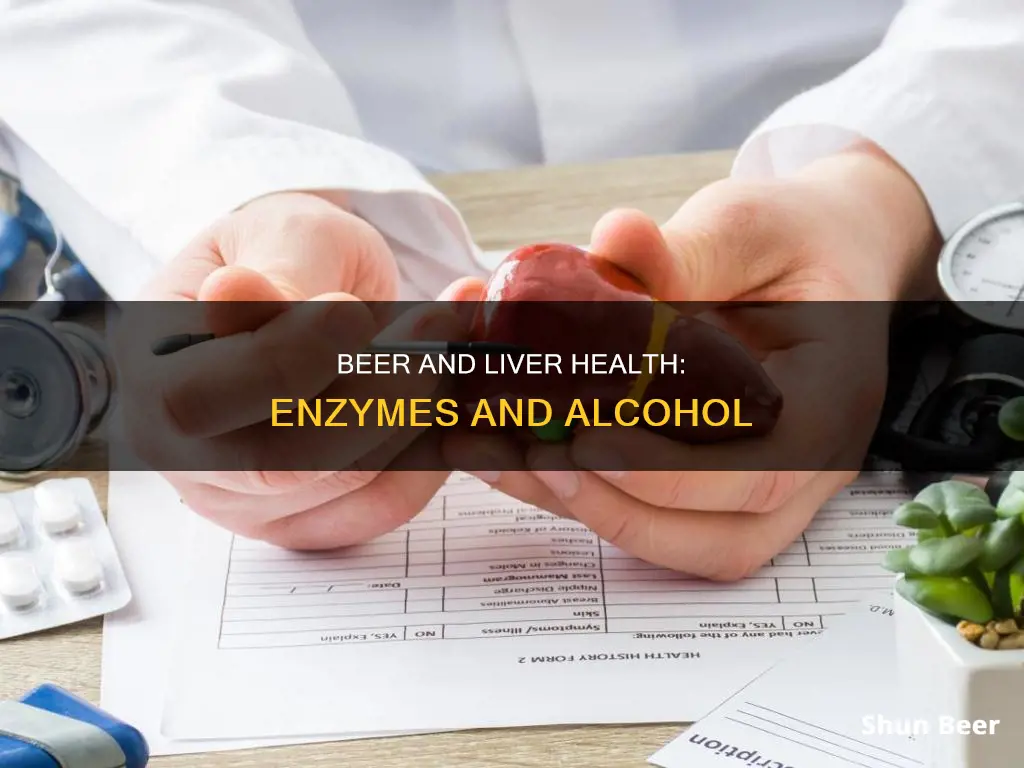
Alcohol consumption is a well-known cause of liver damage. The liver enzymes of those who drink excessively will be affected, regardless of the type of alcohol consumed.
Research has shown that even a short period of excessive drinking can result in liver dysfunction. Binge drinking increases the levels of alcohol-metabolising enzymes, which can cause oxidative damage and other forms of harm to the liver.
The amount of alcohol in a typical 12-ounce beer is the same as that in a shot of liquor or a 5-ounce glass of wine. Therefore, drinking enough beer can also be harmful to the liver.
| Characteristics | Values |
|---|---|
| Alcohol consumption | Any consumption of alcohol, including beer, can increase the risk of abnormal liver enzyme activities. |
| Amount of alcohol | Excessive alcohol consumption is linked to abnormal liver enzyme activities. |
| Gender | Women may show elevated liver enzyme activities following the consumption of smaller amounts of alcohol than men. |
| Age | Older age may increase the risk of elevated liver enzyme activities. |
| Body weight | Excess body weight may increase the risk of abnormal liver enzyme activities. |
| Smoking status | Smoking increases the risk of abnormal liver enzyme activities. |
| Physical activity | Physical inactivity increases the risk of abnormal liver enzyme activities. |
What You'll Learn

Binge drinking and liver damage
Binge drinking is a pattern of drinking that brings blood alcohol concentration levels to 0.08 g/dL. Typically, this occurs after four drinks for women and five drinks for men within about two hours. Binge drinking is associated with increased violence and accidents, and it is a risk factor for advanced alcoholic liver disease.
According to a study by the University of California, San Francisco (UCSF), alcohol consumed during just seven weeks of intermittent binge drinking harms the liver in ways that more moderate daily drinking does not. The scientists discovered that just 21 binge drinking sessions in mice were enough to cause symptoms of early-stage liver disease. Binge drinking produced fatty liver tissue and triggered early stages of inflammation, both indicators of alcohol-induced liver disease. Binging also increased the levels of alcohol-metabolizing enzymes, whose activity can produce oxidative damage and other forms of harm to the liver.
Binge drinking can lead to fatty liver disease, inflammation, and enzyme changes within seven weeks. Excessive alcohol use, which includes binge drinking, results in about 88,000 preventable deaths yearly in the United States and about 2.5 million years of lost life. Most people with an alcohol use disorder develop fatty liver, and of those, about one in five goes on to develop liver cirrhosis, which is often fatal.
Liver disease is on the rise in young people, and doctors are regularly seeing young patients with cirrhosis, which is the medical diagnosis for late-stage liver scarring caused by excessive alcohol use. Binge drinking is most common among younger adults aged 18-34 years, and most people younger than 21 who drink have reported binge drinking as well.
The liver has a unique ability to heal itself and replace damaged tissue with new cells. If liver disease is diagnosed early, doctors can treat it. However, if liver disease is diagnosed in later stages, cirrhosis can develop into an irreversible condition, putting patients at higher risk for liver cancer. In advanced cases, the only treatment is a liver transplant.
Beer and Orajel: A Safe Mix?
You may want to see also

Alcohol intake and abnormal liver enzymes
The relative risk of abnormal liver enzyme activities was found to be higher in male light, moderate, and heavy drinkers compared to abstainers. For female drinkers, the relative risk was higher for moderate and heavy drinkers. The estimated threshold doses for a significant elevation in GGT were 14 standard weekly alcohol doses for men and 7 for women. Excess body weight and age over 40 years lowered these thresholds.
Binge drinking, defined as consuming a large amount of alcohol within a short period, can also lead to liver damage. A study in mice found that just 21 binge drinking sessions were enough to cause early-stage liver disease, with fatty liver tissue, early inflammation, and increased levels of alcohol-metabolizing enzymes. These enzymes can cause oxidative damage and other forms of harm to the liver.
In summary, alcohol intake, regardless of the type of beverage, can lead to abnormal liver enzymes and liver damage. The risk and extent of damage are influenced by various factors, including the amount and frequency of alcohol consumption, age, obesity, smoking, and physical activity.
Beer and Kidney Health: Long-Term Drinking Effects
You may want to see also

Liver cirrhosis and non-alcoholic beer
Liver cirrhosis is a frequent disease that leads to poor quality of life and is the 13th most common cause of death globally. It is characterised by the development of portal hypertension, which can cause ascites, variceal haemorrhage, hepatorenal syndrome and hepatic encephalopathy.
Non-alcoholic beer has been shown to have a positive impact on liver cirrhosis patients. A 2020 study observed that non-alcoholic beer, in combination with diet and exercise, delivered an improvement in the quality of life of cirrhosis patients. The study concluded that non-alcoholic beer, in combination with diet and exercise, is safe and well-tolerated by patients with liver cirrhosis.
Non-alcoholic beer has several nutrients, including vitamin B, minerals and flavonoids, which are beneficial to liver cirrhosis patients. It also has beneficial effects on gut microbiota diversity, endothelial function and oxidative stress.
In conclusion, non-alcoholic beer can be considered a safe and healthy choice for liver cirrhosis patients. However, further studies are needed to confirm the effects of non-alcoholic beer on liver cirrhosis patients.
RV Drinking Laws: Beer and Driving
You may want to see also

Alcohol consumption and liver inflammation
Alcohol consumption is a significant cause of liver inflammation, which can lead to abnormal liver enzyme levels and even liver disease. The risk of abnormal liver enzymes is increased for those who are over 40 years old, obese, physically inactive, or smokers. Even light to moderate alcohol consumption may increase the risk of certain cancers and adverse brain outcomes.
Liver inflammation and abnormal liver enzymes
Alcohol consumption can lead to liver inflammation and abnormal liver enzyme levels, with the risk increasing with age, obesity, physical inactivity, and smoking. Male heavy drinkers have a significantly higher risk of abnormal liver enzymes than male light or moderate drinkers, and female heavy drinkers than female light or moderate drinkers. The relative risks of abnormal liver enzymes were also higher for male heavy drinkers who presented with adiposity and a sedentary lifestyle.
The liver enzymes ALT and GGT are commonly used biomarkers for liver status and are easily measurable and cost-effective. Changes in these liver enzymes may indicate silent liver disease and predict hepatic and extra-hepatic health risks, including metabolic syndrome and cardio- or cerebrovascular events.
Alcohol consumption can lead to liver inflammation and abnormal liver enzyme levels, which can progress to liver disease if left untreated. Binge drinking, defined as consuming a certain number of drinks within two hours, can cause fatty liver tissue and trigger early stages of inflammation, both indicators of alcohol-induced liver disease. Binge drinking also increases the levels of alcohol-metabolizing enzymes, which can produce oxidative damage and other forms of harm to the liver.
In summary, alcohol consumption, regardless of the type of beverage, can lead to liver inflammation and abnormal liver enzyme levels. Binge drinking and heavy drinking increase the risk of liver damage, with male and female heavy drinkers having a significantly higher risk of abnormal liver enzymes than light or moderate drinkers.
Hoppy Beers: The Secret to Better Beer Bread?
You may want to see also

Liver disease and alcohol metabolism
Alcohol is metabolised in the liver, and chronic alcohol consumption is strongly linked to liver disease. The liver is the main organ responsible for metabolising ingested alcohol, but alcohol is also metabolised in other tissues, such as the brain. The liver breaks down alcohol into acetaldehyde, a highly reactive and toxic byproduct that may contribute to tissue damage. Chronic alcohol consumption can lead to fatty liver, inflammation, fibrosis, and cirrhosis.
Alcohol is eliminated from the body by various metabolic mechanisms involving the enzymes aldehyde dehydrogenase (ALDH), alcohol dehydrogenase (ADH), cytochrome P450 (CYP2E1), and catalase. The consequences of alcohol metabolism include oxygen deficits in the liver, the formation of harmful compounds, and the generation of reactive oxygen-containing molecules that can damage other cell components.
Genetic variations can result in the activity of ADH and ALDH (the enzymes needed to process alcohol) varying from person to person. About 50% of East Asian people have a genetic variation that means their ALDH enzyme doesn't work properly, resulting in an inability to process alcohol normally and a rapid rise in acetaldehyde levels. Acetaldehyde is a toxic substance that can cause an unpleasant reaction when it builds up, including flushing of the face, hot sensations, nausea, and palpitations.
Passover Beer: What's Allowed and What's Not?
You may want to see also
Frequently asked questions
No, you should not drink beer if you have high liver enzymes. Alcohol is alcohol, and beer has alcohol. Studies have shown that alcohol consumption increases the risk of abnormal liver enzyme activity.
Liver enzymes are proteins that speed up chemical reactions in the liver. Examples include aspartate aminotransferase (AST) and alanine aminotransferase (ALT).
There are many causes of high liver enzymes, including obesity, alcohol consumption, and viral infections.
There may be no symptoms of high liver enzymes, but some people may experience fatigue, nausea, abdominal pain, or jaundice.







